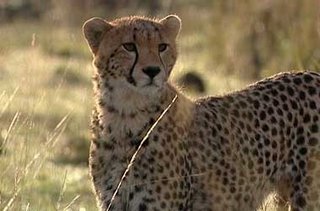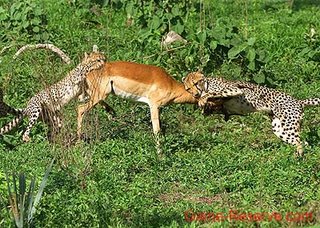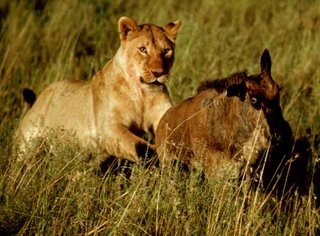
Something quite important just happened on British TV. Well, important to me. Last week the BBC screened Big Cat Week: a series of five programmes broadcast from Kenya’s Masai Mari, and featuring the day-to-day lives of a number of individual wild lions, leopards and cheetahs. This is essentially a pared-down version of Big Cat Diary, a highly successful TV series the BBC has been showing since September 1996 (go see their website here). Screening the individual life histories of particular cats, the series has followed the animals as they have gone about their business hunting, defending territories, courting, mating and raising cubs, and over the years it has become a multi-generational soap-opera as the original stars have died or disappeared, their places being taken by their offspring or by the animals that usurped them. It is easily one of the best things on TV in my opinion – so many remarkable things have been filmed.
As a spin-off for the digital channel BBC Three, the BBC has also been broadcasting Big Cat Week Uncut, with each episode being shown immediately after that day’s Big Cat Week episode. And uncut it truly was. One of things that has always bugged me about nature documentaries is that full acts of predation are almost never shown: you get to see a bit of the chase, then the predators catching their prey, and then a bit of the predators eating the deceased victim. This goes for predation behaviour in lions, hunting dogs, spotted hyaenas, wolves and killer whales.
Why are kills edited? Basically because they are often far more gory than most people expect – kills are often not clean and simple, but may involve the prey animal getting eaten when still alive. Sure, experienced individuals belonging to species that practise precision bites, such as large cats, may well execute a fairly tidy, bloodless killing, but this does not always happen, plus some species – notably hyaenas and hunting dogs – seem to ordinarily take chunks out of the prey while it’s still very much alive. In some cases the prey dies from the resulting trauma and blood-loss, and not from tidy bites to its throat or vital organs. Let me add, by the way, that I’m basing these bold assertions on what I’ve read in books and seen on TV: I have no field experience whatsoever as goes African megafauna. I also want to add that I’m interested in this area, not because I have a love of gore and violence, but because I find macropredation behaviour a fascinating part of the evolutionary biology of the species that practise it.
As you’ve by now guessed, the big deal about Uncut is that it has been showing uncensored kills. To most viewers I hope that these scenes are eye-opening and remarkable, even if gory and horrific, and I have been pleased to see them. Simon King, one of the three presenters*, provides commentary on the footage as he views it. His take on what happens is insightful and accurate, though he has a really annoying habit of describing animals as being ‘designed’ for certain functions. I met King during 2001 when he was presenting Live From Dinosaur Island. We spoke very briefly about co-operative hunting in corvids and raptors, and about Big Cat Diary. I got to tell him how awesome I thought the series was, but that was about it.
* The other two are Jonathan Scott, well known for his work on the Serengeti, and Saba Douglas-Hamilton, qualified social anthropologist and daughter of elephant expert Iain Douglas-Hamilton.
First introduced to the series when she was a tiny cub in 2005, Duma the cheetah is now about a year old and nearly equal in size to her mother (the image of Duma used above is from the Duma slideshow on the BBC website). Both cats were filmed walking through long grass when Duma spotted a Grant’s gazelle Gazella granti reclining ahead, only its horn tips visible. Alerted by Duma’s body language, her mother then began stalking too, and eventually both cats got to within a few metres of the still oblivious gazelle. At up to 80 kg, a male Grant’s gazelle is near the upper limit of the cheetah’s typical prey choice, though they will also take 90-kg antelopes like topi on occasion, and Hans Kruuk documented cheetahs killing wildebeest and young kudus and zebras.

Almost on top of the gazelle, the cheetahs – very interestingly – deliberately startled it into a run (one cheetah, I forget which, did this by hunching its shoulders and making distinctive stiff-legged bounds in the gazelle’s direction). The gazelle didn’t have a chance, and both cheetahs were on top of it immediately. After a bit of a struggle, it was pinned down, and Duma began to administer a throat bite. But it seems she wasn’t very good at it, and gave up far too early. Experienced cheetahs may require 20 minutes to be confident that they’ve suffocated their prey, though this might also be the amount of time it takes for them to recover from the exertions of their run (Brakefield 1993). Duma, however, seemed to be holding on for only a few minutes, if that. The gazelle struggled to its feet and had to be pinned down again. Again, Duma tried a throat bite, and again she gave up too soon. But by now her mother had secured a firm purchase on the gazelle’s rump, had bitten through the skin, and had started feeding on the animal’s haunches. Again the gazelle struggled to its feet, panting and wide-eyed, and again it had to be pinned down. And again another unsuccessful attempt at strangling was performed. As the gazelle stood up again, still struggling and very much alive, it essentially had most of its back end opened up, with a huge bloody hole showing that the mother cheetah had managed to eat in as far as the guts. It was literally being eaten alive. Though the end of the sequence wasn’t shown, King explained that the gazelle must have endured a slow, agonising death [the adjacent image, showing two cheetahs taking down an impala, is nothing to do with Duma or the attack I've just been discussing: it's from game-reserve.com].
In The Velvet Claw (required watching if you’re interested in the evolution of carnivorans: first broadcast by the BBC in 1992), a sequence featuring hostilities between hyaenas and lions showed a similar thing. This time, a lion pride captured a Cape buffalo Syncerus caffer. The lions were clearly eating the animal’s back end, yet its head was up and it was definitely still alive (if I remember correctly, the animal’s head is partially obscured during the sequence by a superimposed ‘less alive looking’ head!).
During another episode of Uncut, King looked in detail at Spotted hyaenas Crocuta crocuta, and in particular at the interactions that hyaenas have with lions. As most people know, the two species hate one another, and will kill each other when the opportunity arises. But with one hyaena weighing (at most) 90 kg compared to a female lion’s 120-180 kg, and a male’s 150-260 kg, hyaenas rarely get to kill adult lions. A lion pride known properly as the Bila Shaka Pride, but dubbed the Marsh Pride for TV, has been a constant presence since filming for Big Cat Diary began. Spending most of their time near Musiara Marsh, the pride’s history is complex (Scott 2001), as is that of any pride when it’s studied for long enough.
 During one episode of Uncut, a hyaena clan spent a lot of time pestering some of the pride’s lionesses. But things went badly wrong for the hyaenas when two male lions showed up. One unfortunate hyaena got stuck in mud: the lions caught it, pinned it down, and one of the lions bit hard into its neck. Smothered in mud, it hung limp in the lion’s jaws. But it wasn’t dead, and when the lion released it, it clamped onto the lion’s upper lip. It was an awesome sequence as, though the hyaena was killed eventually, it endured phenomenal trauma before succumbing. Cats are hard to kill, and I guess hyaenas are too. At the end of the sequence, the lions carried the body out of the mud and water where the fighting had occurred and dumped it on a dry bank. They had no plans to eat the hyaena – they just wanted it dead [the adjacent image is again nothing to do with the case discussed here, and is borrowed from livescience.com].
During one episode of Uncut, a hyaena clan spent a lot of time pestering some of the pride’s lionesses. But things went badly wrong for the hyaenas when two male lions showed up. One unfortunate hyaena got stuck in mud: the lions caught it, pinned it down, and one of the lions bit hard into its neck. Smothered in mud, it hung limp in the lion’s jaws. But it wasn’t dead, and when the lion released it, it clamped onto the lion’s upper lip. It was an awesome sequence as, though the hyaena was killed eventually, it endured phenomenal trauma before succumbing. Cats are hard to kill, and I guess hyaenas are too. At the end of the sequence, the lions carried the body out of the mud and water where the fighting had occurred and dumped it on a dry bank. They had no plans to eat the hyaena – they just wanted it dead [the adjacent image is again nothing to do with the case discussed here, and is borrowed from livescience.com].Dean William Buckland once wrote that predatory animals were equipped with sharp teeth and claws so that death was swift and merciful. While nature isn’t all red in tooth and claw as some people like to say, predation is often decidedly unpretty, and compassion is a human trait. We might not like the idea that predators sometimes start eating their prey while it’s still alive, but the fact that it happens is an interesting facet of their behaviour as worthy of knowing as any other.
For the latest news on Tetrapod Zoology do go here.
Refs - -
Brakefield, T. 1993. Big Cats: Kingdom of Might. Voyageur Press (Stillwater, MN).
Scott, J. 2001. Pride under siege. BBC Wildlife 19 (2), 42-48.
Kudos to the BBC for showing the kills, and thanks for blogging about them. I agree that the popular image of large carnivores is far too sanitized. People need to see this stuff, not because it's cool, but because it's real. Pretending that captured prey animals always meekly surrender to a painless death is not honest or rational, and I can't see any reason to perpetuate that BS.
ReplyDeleteThat’s a very interesting post.
ReplyDeleteI watched quite a lot of both ‘Big Cat Week’ and ‘Big Cat Week Uncut’. I must say that I preferred the ‘Uncut’ version. ‘Big Cat Week’ has become too anthropomorphised and too much like a soap opera (e.g. every episode has to end with a cliff-hanger). The uncut version gave a more honest portrayal of the lives of big cats, but without being gratuitously violent.
I too found Simon King’s references to animals being ‘designed’ irritating. I was beginning to wonder whether he was talking about ‘Intelligent Design’…
I notice that Saba Douglas-Hamilton has been snapped up to:
a) advertise Landrovers;
b) lend credibility to ITV’s ‘Prehistoric Park’ (which looks awful).
Well, when we had our snakes - the Snow corn snake (Frosty) and the Ghost corn snake (Casper)...I never fed them live mice.
ReplyDeleteFirst because it is awful..and the mice scream as they are cornered and strangled. But they can also injure the snake by biting them. So - i played *Little Bunnie Foo-Foo* and bobbed the mice on the head first to kill them (and sometimes froze them to be heated up for meals later).
But when I took the snakes in for my kids *show and tell* day...I fed them (a dead mouse of course) so the could see them eat.
And the Principal freaked out like this was SOO tramatic that a snake would EAT...and children would SEE it.
What a DINK was this Nit-wit Principal we had for our school!
Like it was supposed to be a Disneyesque cartoon-reality with maybe a Snake tea-party for the afternoon meal! Ha!
Actually the kids thought it was KOOL.
:-D
Anyone who has flown birds of prey knows that death can be messy. Big falcons CAN be pretty clean killers. But hawks like the Gos and the smaller sparrowhaks may well start eating before the prey is dead. I carry an ice pick which can administer a quick "coup" without endangering a hawk's toes the way a knife could.
ReplyDeleteDarren I think it's interesting that you were able to view the uncut version of this series in GB, and the same is not availble here in the States. The edited show airs on our cable channel "Animal Planet," which strongly favors the cuddlier aspects of all critters. Normal animal programming here includes Kennel Club dog shows, veterinary clinic programs and various Police "dramas" featuring uniformed officers saving kittens from unqualified homes.
ReplyDeleteWhen I was a kid (early 70s) this wasn't so, and between Natl. Geo. and Wild Kingdom, cheetah kills were a weekly prime time event. Not so much these days...
A falconer friend was contacted last year to fly his Harris' hawks for an episode of Corwin's Quest, which was supposed to show "wild" hawks doing their thing. When my friend suggested they go hawking, Corwin and crew demured and produced instead an "artificial bunny," a stuffed toy rabbit tied to a radio-controlled car. True story.
The hawks were...puzzled.
Falconers are perhaps uniquely aware of unsanitized reality of predation. I often have to intervene to dispatch a rabbit or squirrel which my red-tail hawk has begun to eat, oblivious to the very-much-alive state of his prey.
ReplyDeleteThank you for the information of the uncut version. I never knew one existed. Having seen kills first hand in Kenya, I have always been aware that the series was heavy edited. Now begins the hunt to find the episodes.
ReplyDeleteAnybody who owns a domestic moggie that hunts knows that small fluffy / feathery / scaly / slimy (at a pinch) creatures get eaten alive. I agree with the comments above about the Big Cat Live program becoming a bit of a soap... I fear this may be necessary to make it interesting to the masses. Thank goodness they have not divised a way to have a phone vote to vote off the least popular cats!
ReplyDelete